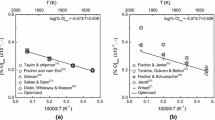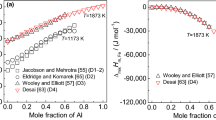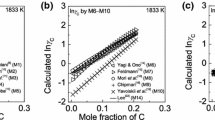Abstract
The reaction abilities of structural units in Fe–C binary melts over a temperature range above the liquidus lines have been evaluated by a thermodynamic model for calculating the mass action concentrations N i of structural units in Fe–C binary melts based on the atom–molecule coexistence theory (AMCT), i.e., the AMCT-N i model, through comparing with the predicted activities aR,i of both C and Fe by 14 collected models from the literature at four temperatures of 1833, 1873, 1923, and 1973 K. Furthermore, the Raoultian activity coefficient \( \gamma_{\text{C}}^{0} \) of C in infinitely dilute Fe–C binary melts and the standard molar Gibbs free energy change \( \Delta_{\text{sol}} G_{{{\text{m, C}}_{{{\text{dis}} .}} ( {\text{l)}} \to [ {\text{C]}}_{{_{{{{w}}_{{[ {\text{C]}}}}}} {= 1.0}}}}}^{{\Theta,{{\%}}}} \) of dissolved liquid C for forming w[C] as 1.0 in Fe–C binary melts referred to 1 mass% of C as reference state have also been determined to be valid. The determined activity coefficient ln γC of C and activity coefficient ln γFe of Fe including temperature effect for Fe–C binary melts can be described by a quadratic polynomial function and a cubic polynomial function, respectively.


















Similar content being viewed by others
Abbreviations
- a i :
-
Activity of element i or compound i;
- a R,i :
-
Activity of element i or compound i relative to pure liquid i or saturated liquid or solid i or pure solid i or diatomic gas i2 as standard state with mole fraction x i as concentration unit and following Raoult’s law under condition of taking ideal solution as reference state, i.e., aR,i = γ i x i ;
- \( a_{\text{R,C}}^{\text{AMCT}} \) :
-
Converted activity aR,C of C in Fe–C binary melts by developed AMCT-N i model;
- a %,i :
-
Activity of element i referred to 1 mass% of element i as standard state with mass percentage w[i] as concentration unit and obeying Henry’s law under condition of taking infinitely dilute ideal solution as reference state, i.e., \( a_{{{{\%,}}i}} = f_{{{{\%,}}i}} w_{[i]} \);
- \( a_{{{{\%,{\rm C}}}}}^{\text{AMCT}} \) :
-
Calculated a%,C of C in Fe–C binary melts by developed AMCT-N i model;
- a H,i :
-
Activity of element i relative to hypothetical pure liquid i as standard state with mole fraction x i as concentration unit and following Henry’s law under condition of taking infinitely dilute ideal solution as reference state, i.e., aH,i = fH,i x i ;
- \( a_{\text{H,C}}^{\text{AMCT}} \) :
-
Calculated aH,C of C in Fe–C binary melts by developed AMCT-N i model;
- b i :
-
Mole number of element i in 100 g metallic melts before reaction equilibrium for forming associated molecules or compounds, having the same meaning with \( n_{i}^{0} \) (mol);
- f %,i :
-
Activity coefficient of element i in metallic melts related with activity a%,i;
- f H,i :
-
Activity coefficient of element i in metallic melts related with activity aH,i;
- \( \Delta_{\text{r}} G_{{{\text{m,}}i}}^{{\Theta,{\text{R}}}} \) :
-
Standard molar Gibbs free energy change of reaction for forming compound i based on activity aR,i for reactants and products (J/mol);
- \( \Delta_{\text{sol}} G_{{{\text{m,}}i_{{{\text{dis}} .}} ( {\text{l)}} \to [i ]_{{{\text{w}}_{{[ {}i ]}} {= 1} . 0}}}}^{{\Theta,{{\%}}}} \) :
-
Standard molar Gibbs free energy change of dissolved liquid element i into metallic melts based on activity a%,i (J/mol);
- \( K_{i}^{{\Theta,{\text{R}}}} \) :
-
Standard equilibrium constant of chemical reaction for forming compound i based on activity aR,i for reactants and products;
- M i :
-
Relative atomic mass of element i;
- \( n_{i}^{0} \) :
-
Mole number of element i in 100 g metallic melts before reaction equilibrium for forming associated molecule or compound, having the same meaning of b i (mol);
- n i :
-
Equilibrium mole number of structural unit i in 100 g metallic melts based on AMCT (mol);
- \( \Sigma n_{i} \) :
-
Total equilibrium mole number of all structural units in 100 g metallic melts based on AMCT (mol);
- N i :
-
Mass action concentrations of structural unit i in metallic melts based on AMCT;
- \( N_{i}^{\prime} \) :
-
Converted mass action concentrations of structural unit i in metallic melts based on AMCT;
- R :
-
Gas constant, 8.314 J/(mol K);
- T :
-
Absolute temperature (K);
- x i :
-
Mole fraction of element i or compound i in metallic melts;
- w [i] :
-
Mass percentage of element i or compound i in metallic melts (%);
- i dis.(l):
-
Dissolved element i or compound i in liquid state;
- γ i :
-
Activity coefficient of element i related with activity aR,i;
- \( \gamma_{i}^{0} \) :
-
Raoultian activity coefficient of element i in infinitely dilute metallic melts relative to pure liquid i or saturated liquid i or pure solid i or diatomic gas i2 (g) as standard state and taking infinitely dilute ideal solution as reference state, i.e., equal to value of \( \gamma_{{i,x_{i} \to 0.0}} \);
References
K. Sanbongi, M. Ohtani, Tetsu-to-Hagané 39 (1953) 483–487.
F. D. Richardson, W. E. Dennis, Trans. Faraday Soc. 49 (1953) 171–180.
K. Sanbongi, M. Ohtani, Sci. Rep. Res. Inst. Tohoku Univ. Ser. A 5 (1953) 263–270.
K. Sanbongi, M. Ohtani, Tetsu-to-Hagané 40 (1954) 1106–1109.
A. Rist, J. Chipman, Rev. Metall. 53 (1956) 796–807.
E. T. Turkdogan, L. E. Leake, C. R. Masson, Acta Metall. 4 (1956) 396–406.
T. Syu, A. Y. Polyakov, A. M. Samarin, Izv. V. U. Z. Chern. Met. 2 (1959) No. 11, 3–12.
S. Ban-ya, S. Matoba, Tetsu-to-Hagané 48 (1962) 925–932.
T. Yagi, Y. Ono, Tetsu-to-Hagané 49 (1963) 133–138.
U. Feldmann, Arch. Eisenhüttenwes 34 (1963) 49–54.
T. Mori, K. Fujimura, H. Okajima, A. Yamauchi, Tetsu-to-Hagané 54 (1968) 321–329.
G. L. Howkes, D. R. Morris, Trans. Metall. Soc. AIME 242 (1968) 1083–1089.
J. Chipman, Metall. Trans. 1 (1970) 2163–2168.
V. I. Yavoiskii, A. G. Svyasin, A. F. Vishkarev, K. B. Nguyen, A. D. Romanovich, G. M. Chursin, Russ. Metall. 3 (1971) 33–40.
A. Ueda, K. Fujimura, T. Mori, Tetsu-to-Hagané 61 (1975) 2962–2971.
S. Matoba, S. Ban-ya, Tetsu-to-Hagané 66 (1980) 1406–1422.
Y. E. Lee, Metall. Mater. Trans. B 29 (1998) 397–403.
J. Chipman, Metall. Trans. 3 (1972) 55–64.
J. Ågren, Metall. Trans. A 10A (1979) 1847–1852.
E. Schürmann, R. Schmid, Arch. Eisenhüttenwes 50 (1979) 101–106.
H. Okamoto, J. Phase Equilib 13 (1992) 543–565.
X. M. Yang, M. Zhang, P. C. Li, J. Y. Li, J. L. Zhang, J. Zhang, Metall. Mater. Trans. B 43 (2012) 1358–1387.
X. M. Yang, M. Zhang, P. C. Li, J. Y. Li, J. Zhang, Steel Res. Int. 84 (2013) 784–811.
X. M. Yang, J. Y. Li, P. C. Li, M. Zhang, J. Zhang, Steel Res. Int. 85 (2014) 164–206.
X. M. Yang, P. C. Li, J. Y. Li, J. L. Zhang, M. Zhang, J. Zhang, Steel Res. Int. 85 (2014) 426–460.
X. M. Yang, J. Y. Li, M. F. Wei, J. Zhang, Metall. Mater. Trans. B 47 (2016) 174–206.
J. Zhang, Computational Thermodynamics of Metallurgical Melts and Solutions, Metallurgical Industry Press, Beijing, China, 2007.
X. M. Yang, J. S. Jiao, R. C. Ding, C. B. Shi, H. J. Guo, ISIJ Int. 49 (2009) 1828–1837.
C. B. Shi, X. M. Yang, J. S. Jiao, C. Li, H. J. Guo, ISIJ Int. 50 (2010) 1362–1372.
X. M. Yang, C. B. Shi, M. Zhang, G. M. Chai, F. Wang, Metall. Mater. Trans. B 42 (2011) 1150–1580.
X. M. Yang, C. B. Shi, M. Zhang, G. M. Chai, J. Zhang, Metall. Mater. Trans. B 43 (2012) 241–266.
X. M. Yang, J. P. Duan, C. B. Shi, M. Zhang, Y. L Zhang, J. C. Wang, Metall. Mater. Trans. B 42 (2011) 738–770.
X. M. Yang, C. B. Shi, M. Zhang, J. P. Duan, J. Zhang, Metall. Mater. Trans. B 42 (2011) 951–976.
X. M. Yang, C. B. Shi, M. Zhang, J. Zhang, Steel Res. Int. 83 (2012) 244–258.
X. M. Yang, M. Zhang, J. L. Zhang, P. C. Li, J. Y. Li, J. Zhang, Steel Res. Int. 85 (2014) 347–375.
J. Y. Li, M. Zhang, M. Guo, X. M. Yang, Metall. Mater. Trans. B 45 (2014) 1666–1682.
X. M. Yang, J. Y. Li, G. M. Chai, M. Zhang, J. Zhang, Metall. Mater. Trans. B 45 (2014) 2118–2137.
J. Y. Zhang, Metallurgical Physicochemistry, Metallurgical Industry Press, Beijing, 2004.
X. H. Huang, Principles of Ironmaking and Steelmaking, 3rd ed., Metallurgical Industry Press, Beijing, 2005.
S. K. Wei, Thermodynamics of Metallurgical Processes, Science Press, Beijing, 2010.
J. Chipman, R. M. Alfred, L.W. Gott, R. B. Small, D. M. Wilson, C. N. Thomson, D.L Guernsey, J.C. Fulton, Trans. Am. Soc. Metals 44 (1952) 1215–1232.
J. A. Kichener, J. Bockris, D.A. Spratt, Trans.Far. Soc. 48 (1952) 608–617.
E. T. Turkdogan, L. E. Leake, J. Iron Steel Inst. 179 (1955) 39–45.
S. Matoba, S. Ban-ya, Tetsu-to-Hagané 43 (1957) 790–796.
K. Suzuki, M. Fukumoto, Y. Nakagawa, J. Jpn. Inst. Met. Mater. 30 (1966) 50–51.
19th Committee on Steelmaking, Japan Society for the Promotion of Science, Steelmaking Data Sourcebook, Gordon and Breach Science Publishers SA Montreux, Switzerland, 1988.
Acknowledgements
This work is supported by the Beijing Natural Science Foundation (Grant No. 2182069) and the National Natural Science Foundation of China (Grant No. 51174186).
Author information
Authors and Affiliations
Corresponding author
Rights and permissions
About this article
Cite this article
Yang, Xm., Li, Jy., Duan, Dp. et al. Thermodynamic evaluation of reaction abilities of structural units in Fe–C binary melts based on atom–molecule coexistence theory. J. Iron Steel Res. Int. 25, 37–56 (2018). https://doi.org/10.1007/s42243-017-0008-9
Received:
Revised:
Accepted:
Published:
Issue Date:
DOI: https://doi.org/10.1007/s42243-017-0008-9




